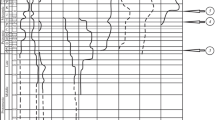Abstract
The Palaeozoic and Mesozoic eras were terminated by faunal changes involving mass extinction of the old and explosive evolution of the new fauna, but the fossil record shows only a Cambrian Explosion at the end of the Precambrian. Stanley speculated that the explosion was only possible after the ubiquitous algae community had been largely eliminated1; ecological niches were thus liberated for explosive evolution. If the Cambrian Explosion were preceded by a mass mortality (or by a mass extinction), such an event should leave a record in the form of geochemical anomalies. We have undertaken a search for geochemical anomalies at the Precambrian/Cambrian contact. We report here the discovery of a sharp negative carbon-isotope shift in the carbonate of a clay immediately above a marker in the Precambrian/Cambrian boundary, the China C marker, and interpret this signal as evidence of sudden decrease in fertility before the Cambrian explosion of invertebrate evolution. The discovery suggests that the Precambrian/Cambrian boundary might be defined by an event-marker at a palaeontologically correlative horizon.
Similar content being viewed by others
References
Stanley, S. M. Proc. natn. Acad. Sci. U.S.A. 70, 1486–1489 (1973).
Alvarez, L., Alvarez, W., Asaro, F. & Michel, H. V. Science 208, 1095–1108 (1980).
Hsü, K. J. et al. Science 216, 249–256 (1982).
et al. in Contr. 27th int. Geol. Congr. 225–234 (Science Press, Beijing, 1984).
Luo, H. et al. Sinian-Cambrian boundary stratotype section at Meischucun, Jinning, Yunnan, China (People's Publishing House, Yunnan, 1984).
Jiang, Z. Bull. Chin. Acad. Geol. Sci. Ser. I, 2, 88–92 (1980).
Kroopnick, P., Margolis, S. V. & Wong, C. S. Earth Planet. Sci. Lett. 22, 397–403 (1974).
McKenzie, J. A. in Nature and Origin of Cretaceous Carbon-Rich Fades (eds Schlanger, S. O. & Cita, M. B.) 197–207 (Academic, New York, 1982).
Hsü, K. J. & McKenzie, J. A. Natural Variations of CO2 in Earth History (American Geophysical Union, Monograph, in the press).
Kelts, K. & Hsü, K. J. in Lakes (ed. Lerman, A.) 295–323 (Springer, Heidelberg, 1978).
Seilacher, A. in Patterns of change in Earth Evolution (eds Holland, H. D. & Trendall, A. F.) 159–170 (Springer, Berlin, 1984).
Fan, Delian, Van Ruiying & Huang Zhongxiang in Contr. 27th int. Geol. Congr. 215–224 (Science Press, Beijing, 1984).
Krähenbühl, U. Chimia 38, 107–113 (1984).
Author information
Authors and Affiliations
Rights and permissions
About this article
Cite this article
Hsu, K., Oberhänsli, H., Gao, J. et al. ‘Strangelove ocean’ before the Cambrian explosion. Nature 316, 809–811 (1985). https://doi.org/10.1038/316809a0
Received:
Accepted:
Issue Date:
DOI: https://doi.org/10.1038/316809a0
- Springer Nature Limited
This article is cited by
-
SHRIMP zircon age for a K-bentonite in the top of the Laobao Formation at the Pingyin section, Guizhou, South China
Science China Earth Sciences (2013)
-
SIMS U-Pb zircon age of a tuff layer in the Meishucun section, Yunnan, southwest China: Constraint on the age of the Precambrian-Cambrian boundary
Science in China Series D: Earth Sciences (2009)
-
SHRIMP U-Pb zircon age of tuff at the bottom of the Lower Cambrian Niutitang Formation, Zunyi, South China
Chinese Science Bulletin (2008)
-
Carbon and oxygen isotope profiles from the terminal precambrian Marwar Supergroup, Rajasthan, India
Carbonates and Evaporites (2003)
-
Die kambrische Explosion
Paläontologische Zeitschrift (1998)





